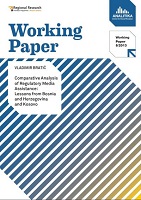Comparative Analysis of Regulatory Media Assistance: Lessons from Bosnia and Herzegovina and Kosovo
Comparative Analysis of Regulatory Media Assistance: Lessons from Bosnia and Herzegovina and Kosovo
Author(s): Vladimir Bratić
Contributor(s): Kristina Irion (Editor), Tarik Jusić (Editor), Sanela Hrlović (Editor)
Subject(s): Politics, Media studies, Human Rights and Humanitarian Law, Public Law, Communication studies
Published by: Analitika – Centar za društvena istraživanja
Keywords: BiH: Kosovo; media; regulatory media assistance; comparative analysis; free speech; legislation; policy;
Summary/Abstract: Generally, international media assistance can help any media system with the positive and negative interventions. Positive interventions, on the one hand, provide incentives and support the forces in the desired direction. Negative interventions, on the other hand, suppress unwanted practices which inhibit the desired outcome. Peace building is not any different and post-conflict media strategies are concerned with both positive and negative role of media in reconciliation. Most of the projects described in the literature deal with positive interventions – orchestration of positive media practices that contribute to peace: development of professional journalism, building media institutions and promotion of content in support of lasting peace. Nonetheless, negative interventions are often necessary to curb media practices that enable the continuation of conflict discourse. Even though the cessation of direct violence marks a decisive step in transforming conflict, sustainable peace depends on the eradication of other forces that are destructive to peace development. The majority of conflicts since the Cold War have been reinforced through carefully orchestrated media machines. Even after political agreements bring an end to physical violence, propaganda and inciting messages tend to prolong the culture of violence. Violence often continues to exist in a non-tangible form – cultural violence – as aspects of culture (e.g. religion, language, art) which function as the symbolic sphere of our existence. Cultural violence continues to exist most prominently in the media and as such represents a major obstacle to the peaceful transformation of conflict. Hence, the critical component of peace building media strategy that has been widely underreported concerns the regulation of residual violence-inciting, conflict-promoting media environment. While the intervention with peaceoriented information in conflict is necessary, “intervention against certain kinds of information” has not been a priority of most media interventions. Therefore, this chapter deals with the regulation process that centers on the development of legal environment which protects free speech and democratic media discourse while preventing inflammatory language, hate speech and verbal incitement. While the two approaches may appear to be in opposition, a more complementary practice developed over the last two decades. Nowhere else has this duality of media assistance been prominent as in the post-conflict recovery in Bosnia and Herzegovina (B&H) and Kosovo. In both of these cases, the initial media projects centered on journalism reform because at the time of the first post-Cold War conflicts, a quick model for news media improvement in conflict societies did not exist. A model of the media development at the time existed in the former communist countries in democratic transition (e.g. former Soviet bloc, Latin America and parts of Asia) and it focused on elimination of censorship and careful nurturing of independent press. However, years after the peace agreements were signed in both countries, the professionally-run, independent media were slow to make visible changes because they could not compete with the old, nationalist media sources (i.e. national broadcasters). The audiences stuck with the coverage of nationalist media which was frequently biased and often even hateful. Moreover, the new, independent media failed to attract larger audiences, despite their professional and objective journalism. The international administrators in charge of the media strategy believed that, when presented with the appropriate options, people would make the right choice (i.e. choosing objective media over biased ones) but the success of the nationalist media negated such assumption. The media strategists failed to understand that pluralism requires more than the saturation of the environment with new media outlets. This is when the reform of the regulatory environment became the focus of the media assistance in the region. However, the model of what regulatory reform of a conflict media needed to be was an enigma at this point. This chapter argues that the two experiences from the conflicts in B&H and Kosovo provided the answer of what regulative practice in conflict zones must contain. Not only have the two case studies established the variety of practices necessary for a comprehensive regulatory reform; they also came at the time when policy makers and academics came together to label this area of media assistance as “enabling environment” in one of the most influential studies for the USAID by Price and Krug. A decade later, many experts would agree that regulation efforts were possibly the best practice of media assistance and the basis for post-conflict intervention regulation paradigm. As such, the model of regulation from the Balkans will be seen as instrumental in the entire field of peace building media and a baseline for the future intervention in the conflicts in Iraq and Afghanistan. The chapter is structured as follows: The rationale for the production of positive media promoting peace building (e.g. journalism training, professionalization and development of peace-oriented media) is easily understandable and widely acceptable. The rationale for regulation of conflict media has not been as popular or easily understood. Therefore, it becomes highly important to understand the history of regulatory practices, provide the justification of its usefulness while remaining cognizant of the signpost issues surrounding the regulation (e.g. free speech v. hate speech). Finally, the two case studies of regulation from B&H and Kosovo are presented with the focus on implementation of regulation strategies (i.e. protection of free speech, suppression of incendiary media and development of regulatory authorities) that will serve as a basis for the media development known as “enabling environment” or the process of building media laws and institutions that support free and independent media.
Series: ANALITIKA — Working Paper
- Page Count: 41
- Publication Year: 2013
- Language: English
- Introduction
- Content File-PDF

